Stretching exercise
Introduction:
Stretching is one type of physical exercise in which a specific muscle or tendon is constantly flexed or stretched to improve muscle flexibility and gain comfortable muscle tone. The aim of stretching is increased muscle control, flexibility, and range of motion.This may not be the most exciting part of working out, but doing flexibility work is super important in a well-rounded fitness routine. Incorporating some stretching exercises into your workout schedule can help you improve flexibility, decrease tightness, and, ultimately make your workouts whether we were talking about strength or cardio routines more efficient and safe.
Tight muscles can induce strain on the nearest joints during activities of daily living or they can become injured. As you grow up, your muscles get shorter and less elastic. We need to participate actively to maintain and improve the length of our muscles so we can continue to enjoy our abilities without pain.
Indeed, stretching is not exactly glamorous, and it probably would not give you the same rush that a run or HIIT class will. This is not comfortable and it takes your time, so people do not like to do it. You can not just do strength training and cardio without putting yourself at risk for injury and pain. By doing a ton of work that contracts the muscles (which shortens them) and never stretching (lengthening) them, your muscles will end up imbalanced. Imbalances in the body increase the risk of injury because they can cause some muscles and joints to overcompensate for other structures that are too tight to engage properly. This leads to strains and discomfort.
That is where stretching comes in, whether we were talking about back stretches, upper-body stretches, or leg stretches. Wherever your muscles are contract, stretching and flexibility exercises can bring a more benefit.
Health Benefits of stretching exercise:
- Helps to Improve your performance in games.
- Helps to Decrease your risk of injury to the joint.
- Helps your joints move through their full range of motion.
- Helps to Improve muscle blood flow. Helps your muscles to work most effectively.
- Assist to enhance your ability to do activities of daily living.
There have lots of benefits to stretching. one time, stretching gain flexibility, which can increase your short-term and long-term range of motion. That is important since a better range of motion can mean better muscle recruitment during your workouts, as self-reported previously. For example, a full range of motion in your hips and knees will allow you to sink deeper into squatting. Ultimately, having a greater ROM will make it so you can perform more exercises and do them properly.
For me, it is about daily things that become harder the older you get, like bending down to tie a shoe, walking upstairs, picking your kid up from the floor, or even just getting up off the couch.” Improving your mobility makes these daily activities easier you can move more freely.
Stretching can help to improve pain, which can result from the tightening that occurs during workouts or when we were hunched over our desks for hours on end. It can also alert you to muscle imbalances say, if one side is tighter than the other when you are going into one of your favorite hip flexors stretches.
When should you stretch?
The type of stretching matters when we are talking about the best time to stretch. Dynamic stretching involves a movement that prepares your body for a workout. stretching before a workout includes movement-oriented moves like cat-camel, down dog to walking lunge, or threading the needle. On the other hand, static stretching (when you hold a position) helps your body calm down after a workout, which helps jump-start the recovery process. Complete your workout with static stretches can help your mind relax and signal an endpoint to your workout. We will be focusing on static stretches in the moves below.
Doing stretching is not much hard to improve your flexibility and mobility. It just takes a small time.If you are experiencing joint pain or discomfort, or are looking for specific exercises for pain relief or stretches for lumber pain, you may want to chat with your physical therapist before starting a stretching routine or doing foam rolling exercises. They can let you know which specific moves might be best for your personal needs.
All stretching should be done concerning pain. There should be no exacerbation of pain during or after the exercises.Please consult your doctor for a full assessment and diagnosis before commencing any of these stretching exercises.
Types of Stretching Exercise
There have different types and each offers a unique benefit. Some common types of stretching include:
Passive stretching
In this technique, you are relaxed and do not contribute to the range of movement. Instead, an outside person creates force, either manually or mechanically.Think gym class, when you used to flex over and reach down toward your toes. For this type of stretching, an outside force (such as a towel, resistance band, gravity, or therapist) helps to increase the stretch. It is commonly done after a workout, and for relaxation.
Static stretching
Static stretching involves extending a limb to create a stretch sensation and then holding it there often for seconds, according to the Hospital for Special Surgery. While the terms static stretching and passive stretching are mostly used interchangeably, there is a minimum difference. Static and passive stretching is similar in that you are holding a stretch, but unlike passive stretching, with static stretching, you are in some way supporting yourself in the position of the stretch. As with passive stretching, static stretching is also commonly performed after working out and for relaxation.
Active stretching
This stretching is done by your self in this you move a limb into a position to stretch a muscle and then hold it there under your muscular power. For example, you have to take a supine lying position and use your leg muscles to raise one straight leg until you feel a stretch in your hamstrings. This method can be helpful for people who are recovering from injuries because it helps to gentle strength work.
Isometric stretching
Isometric stretching adds a static muscle contraction in which the muscle does not change its length to a static or active stretch. There has some force pushing against the muscle you are stretching. An example is a calf stretch in which you lunge one foot forward, straighten your posterior leg with your heel pressing down, and push into a wall in front of you with your hands. Typically, you alternate between contracting the muscle for ten seconds and stretching the muscle for thirty seconds, and repeating for three to 6 repetitions. This stretching can be helpful for people who want to like rapid advances in flexibility because it sends more signals from the nervous system that tell the muscles to stretch further.
Proprioceptive neuromuscular facilitation (PNF)
PNF is like isometric stretching, except that the contract-relax scheme could be done for a much shorter time fifteen-second stretch, and a seven-second contraction.PNF stretching technique also includes a contraction of the muscle opposite the muscle being stretched. So, a hamstring stretch would look like this. Lie on your back and have someone lift one leg toward the sky until you feel a stretch in the back of your lifted leg. Hold there for 15 to 30 seconds. Contract the hamstring for 7 to 15 seconds, and then contract the quadriceps for 7 to 15 seconds. Relax and let your hamstring be stretched a little more. Hold for 20 to 30 seconds. Contractions are held for 1/2 the time of stretches.
Dynamic stretching
You performed controlled exercises to move your muscles length with the full range of motion, which helps you warm up for a workout and tells your brain to get ready to move. In dynamic stretching, you move your muscles to extend. Walking lunges, leg swings, and trunk twists are just a few examples of dynamic stretching.
Somatic stretching
As other stretching somatic stretching does not require holding a stretch for a prolonged period. You have to release muscular tension through gentle, natural movements, with an emphasis on tuning in to how the muscles feel. Like your head hangs and pay attention to the sensations that come with it or arch your back and stretch upon waking.
Here we explain the different stretching exercise.
Seated Neck Release

- This stretch helps to relieve tension in your neck and makes a positive impact on the rest of your upper limb, from your shoulders to your spine.
- To do this stretch you can Stand with feet shoulder-width apart, or sit down with your back straight and chest lifted.
- Move your head to the right side to touch your right ear to your right shoulder.
- To get more stretch, gently press down on your head with your right hand.
- Hold for thirty seconds to two minutes.

Triceps Stretch
- Elevate your right arm above your head so your elbow points in the upward direction.
- Use left hand, pull the elbow behind the neck while keeping Trunk and neck facing forwards and upright.
- Hold for 30 seconds. Repeat 3 times.
- Practice 2 to 3 sets 2 times daily.
Triceps Stretch and Internal Rotation Stretch
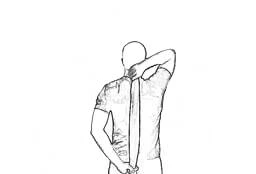
- Elevate the arm above the head so the elbow points upwards, put the other arm behind the back, and lift as much along the back as possible. If able hold the fingers of the other hand and curl your fingers to increase the stretch.
- Hold for 30 seconds. Repeat 2 to 3 times.
- Practice 2 sets 2 times daily.
Shoulder and Triceps Stretch
- Cross your arm over the chest at shoulder height and use the opposite arm to hug into the chest. Your trunk facing forward.
- Hold for 20 to 30 seconds. Repeat 2 times. Practice 2 to 3 sets 2 times daily.
Biceps and Anterior Capsule Stretch

- To perform this you have to Stand and reach both hands behind your back. If able make a fist or close your fingers and raise your arms higher behind back.
- Hold for 30 seconds. Repeat 3 times. Practice 3 sets 2 times daily.
Bilateral Standing Pectoral and Bicep Stretch
- Stand facing the corner wall, raise arms to ninety degrees with flexed elbows, so that forearms run along the wall vertically. Lean forward into a wall with the torso to increase the stretch.
- Hold for 30 seconds. Repeat 2 times. Practice 3 sets 2 times daily.
Unilateral Standing Pectoral and Biceps Stretch
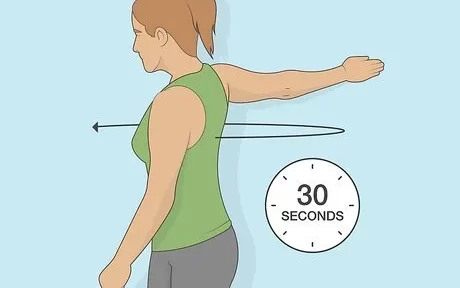
- You have to stand with the Facing wall, and place your palm on the wall with your arm at ninety degrees.
- Turn the face, torso, and body to become side to the wall to increase the stretch.
- Hold for 30 seconds. Repeat 3 times. Practice 3 sets twice daily.
Complete Upper Limb Stretch
- Interlock fingers, turn palms so they face outwards,then elevate arms straight above head to become vertical with ears and shoulders.
- Hold for 30 seconds. Repeat 3 times.
- Practice 3 sets two times daily.
Upper Back and Posterior Shoulder Stretch
- Utilize your both hands to reach around the body to grab shoulder blades.
- Crawl fingers further around the back to get stretch.
- Hold for 30 seconds.
- Repeat three times. Practice 3 sets two times daily.

Seated Shoulder Squeeze
- You like this stretch because it relieves poor posture and releases tension in the upper back.
- Sit down with your knees flexed and feet flat on the ground. Put your hand on the wall.
- Straighten and extend your arms and squeeze your shoulder blades together.
- Do this for 3 seconds and then release. Repeat 5 to 10 times.
Wrist Flexor Stretch

- Use your other hand to pull back your fingers and wrist whilst straightening the elbow and taking the arm to ninety degrees in front of the body.
- Hold for 30 seconds. Repeat 3 times. Practice 3 sets 2 times daily.
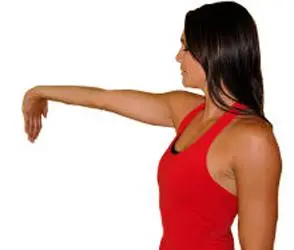
Wrist Extensor Stretch
- Use another hand to pull fingers and wrist downwards whilst straightening the elbow and taking an arm to ninety degrees in front of the body.
- Hold for 30 seconds. Repeat 2 to 3 times.
- Practice 3 sets two times daily
Gate Pose
- To perform a gate pose you have to take a kneeling position then extend your left leg to the side with your toes facing forward or to the right.
- Flexed to the right, placing your right hand along your leg.
- Straighten your left hand up and over, reaching to the right side.
- Extend through your left fingertips and roll your left ribs up toward the sky.
- Hold this position for seconds.
- Repeat this on both sides.
Cobra Pose

Cobra Pose(Bhujangasana) is a transverse abdominis muscle stretching exercise.
This pose helps to open up your hips and gives your abdominal muscles a gentle stretch.
- To do this stretch you have to lie with your face facing downward on the ground or on an exercise mat.
- This is your starting position. With your hips flat on the floor, push your upper limb upward, while looking straight ahead.
- This will stretch the abdominal muscles.
- Hold this pose for twenty seconds, then return to the initial position.
Stand and Bend
This is an oblique muscle stretching exercise.
- Stand and bend not only stretches your oblique muscles but also helps to stretch your anterior abdominal muscles and the muscles that run along your spinal column.
- Begin this stretches by standing with your feet shoulder-width apart and both feet parallel.
- To do this stretch you have to do a Intertwine your fingers and extend your arms overhead, turning your palms up toward the sky.
- Inhale through nose and engage your abdominals and glutes.
- Breathe out and bend to your right, your hips should be steady throughout the exercise.
- Hold it for 40 seconds, then return to the initial position.
- Repeat this stretch on both sides.
Basic Standing Stretch
This is a Rectus abdominis stretching exercise.
- This stretch is the most basic stretch for the rectus abdominis is the standing abdominal stretch.
- To perform this stretch you have to Stand tall with your feet together and elevate your arms over your head.
- Your fingers are extended so the palms of your hands are facing the sky. raise your chest as you arch your back. your arms should be extended toward the sky as you move your arms behind your head.
- Hold this stretch for thirty seconds and then rest for thirty seconds before performing the stretch two more times.
Cat cow pose

- To do this stretch you have to come on all four limbs in position, and draw your head down as you arch your back, the same as a cat does.
- Stretch the neck muscles by looking upward direction, and sink your tummy all the way downwards, stretching the abdominal muscles.
- Hold this abdominal stretch for 35 seconds, then back to the initial position.
- Repeat 3- 4 times.
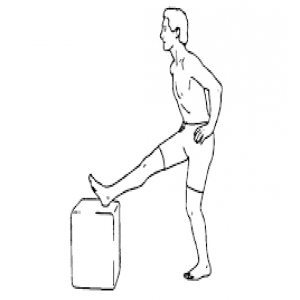
Standing Hamstring Stretch
- Take a Standing position with your feet hip-width apart, knees slightly flexed, and arms by your sides.
- Breathe out as you flex forward at the hips, lowering your head toward the floor while keeping your head, neck, and shoulders relaxed.
- Wrap your arms around the backs of your legs and hold anywhere from 30 seconds to 3 minutes.
- Flexed your knees and roll up when you are done.
Piriformis Stretch
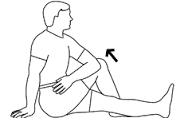
- This muscle is a deep internal hip rotator, located on the outside of the buttock. Its main role is external rotation. Deep internal rotators, while small, produce a lot of movement at the hip and are often overlooked.
- The piriformis muscle crosses over the sciatic nerve, if this muscle is tight, it can cause sciatic nerve irritation. Stretching the piriformis muscle can prevent potential future sciatica, or help to treat sciatic nerve pain.
- Sit on the ground with both legs straighten in front of you.
- Cross your right leg over your left, and place your right foot flat on the ground.
- Put your right hand on the ground posterior to your body.
- Put your left hand on your right quadriceps or your left elbow on your right knee (as shown) and contract your right leg to the left as you rotate your torso to the right.
- If the spinal twist bothers your back, take it out and simply use your left hand to pull your right quadriceps in and to the left.
Lunge With Spinal Twist
This stretch is helpful with posture-related pain or for people who sit for periods of a long time. It helps to open your hips and increase thoracic (mid-back) mobility.
This stretching Start by standing with your feet together. Take a long step forward with your left foot, so that you are in a staggered stance.
- Flexed your left knee and come into a lunge position, keep your right leg straight behind you with your toes on the floor, so you feel a stretch at the front of your right thigh.
- Put your right hand on the floor and twist your upper body to the left as you extend your left arm toward the sky.
- Hold for 30 seconds for 3 sets.
- Repeat on the other side.
Figure Four Stretch

- Figure Four Stretches are usually done for the piriformis and iliopsoas muscles (essentially your hip rotator and flexor muscles) and the I.T. band. The figure of four poses is an excellent and gentle approach to help and relieve symptoms associated with sciatica and knee pain.
- To do this stretch you have to Lie on your back with your feet flat on the ground.
- Cross your right foot over your left front thigh.
- Lift your left leg off the ground. hold back your right leg and gently pull it toward your chest.
- When you feel comfortable stretching, hold this position.
- Hold for thirty seconds for three sets.
- Switch sides and repeat.
90/90 Stretch

This stretch is a modification of the pigeon pose it will help to do the internal rotation of one leg and external rotation of the other, so you are hitting both movements of the hip at the same time. It is a good option for people who have extremely tight hip flexors. The front thigh is safely on the ground in a position that doesn’t cause too much stress.”
- Sit with your left knee bent at ninety degrees in front of you, your calf perpendicular to your body, and the sole of your foot facing to the right.
- Keep your right foot flexed. Let your leg rest flat on the ground.
- Place your right knee to the right of your body, and flex the knee so that your foot faces behind you.
- Keep your right foot flexed. Keep your left buttocks cheek on the ground.
- Try to move the right cheek as close to the ground as possible.
- It may not be possible if you are super tight. Hold for thirty seconds for 3 sets.
- Repeat this on the opposite side.
Frog Stretch
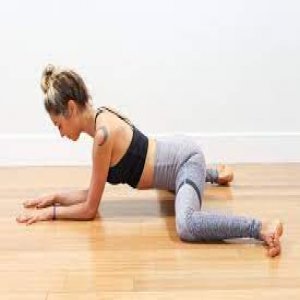
Most people sit and cross both legs, which can lead to tight hips and result in lower back pain. This stretch directly targets tight spots in the hips/groin and is especially useful for athletes.
- To perform this exercise Start on all four.
- Move your knees wider than shoulder-width apart.
- Move your toes outward and rest the inner edges of your feet flat on the floor.
- Shift your buttocks back toward your heels.
- Move from your hands to your forearms to get a deeper stretch, if comfortable.
- Hold for thirty seconds for 3 sites.
Butterfly Stretch

- Sit tall on the ground with the soles of your feet together, your knees flexed out to the sides.
- Hold onto your ankles or feet, engage your abdominals, and slowly lower your body toward your feet as far as you can while pressing your knees toward the ground.
- If you are too tight to bend over, simply press your knees down.
- Hold this stretch for thirty seconds for 3 sets.
Side Bend Stretch
- Kneel on the ground with your legs together, back straight, and core tight.
- Extend your right leg out to the side. it must be perpendicular to your body (not in front or behind you).
- Extend your left arm overhead, rest your right arm on your right leg, and gently bend your trunk and left arm to the right side.
- Your hips should be facing forward. Hold this stretch for thirty seconds for 3 sets.
- Repeat on the opposite side.
Lunging Hip Flexor Stretch

- Kneel on your right knee. Place your left foot flat on the floor in front of you, knee flexed.
- Lean forward, stretching your right hip toward the ground.
- Contract your glutes, this will allow you to stretch your hip flexor even more.
- Hold for 30 seconds for 3 sets.
- Switch sides and repeat.
Knee to Chest Stretch
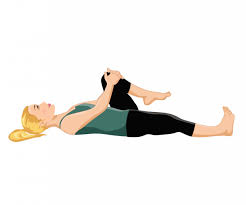
- To perform this stretch you have to Lie on your back with both legs extended.
- Pull your left knee into your chest, while keeping the right leg straight and your lower back pressed into the ground.
- Hold for thirty seconds for three sets.
- Repeat on the opposite leg.
Lying Quad Stretch
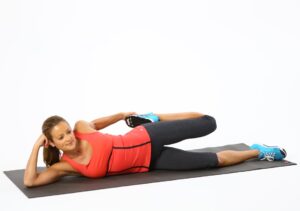
A quadriceps stretch is one of the most popular lower limb stretches, especially if you have just done a cardio workout like running or cycling. This stretch is exactly opposite to the typical standing variation and takes balance out of the equation.
- To perform this exercise you have to Lie on one side.
- Keep your bottom leg straight and flex your top knee so your foot is by your buttocks.
- Hold your top foot with your hand, pulling it toward your buttocks.
- Keep your hips stable so you are not rocking back as you pull.
- Hold for thirty seconds for 3 sets.
- Switch sides and repeat.
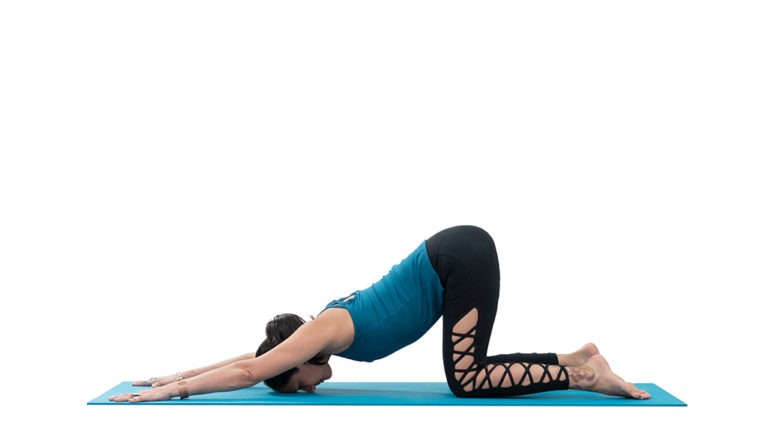
Extended Puppy Pose
- To perform this exercise you have to Start on all four limbs.
- You have to Walk on your arms forward a few inches and curl your toes under.
- Move your hips upward and back halfway toward your heels.
- Push through your palms to keep your arms straight and engaged.
- Hold for thirty seconds for 3 sets.
Pretzel Stretch
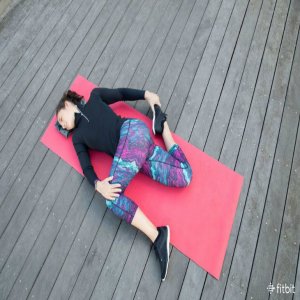
You will stretch the quads of your upper thigh, your spine, and the glutes and hip flexors of your top leg.
- To perform this exercise you have to Lie on your right side with your head resting on your arm.
- Flexed your left knee and hip up toward your chest as much as you can, and let it drop to the ground.
- Bend your right knee and hold your right foot (use a strap if you can’t reach it) with your left hand.
- Make sure your leg and trunk remain in a straight line as you gently bring your top shoulder blade toward the ground.
- For more of a spinal twist, turn your head to look over your left shoulder.
Reclining Bound Angle Pose
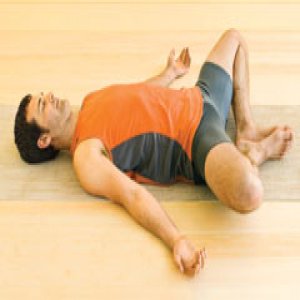
This is a perfect releasing pose and the best stretching for a workout.
- To do this stretch you have to Lie on your back.
- Move the soles of your feet together and allow your knees to open up and move closer to the ground.
- Hold for thirty seconds 3 times.

Standing Quad Stretch
- To perform this stretch you have to Stand with your feet together.
- Flexed your right knee and use your right hand to pull your right foot toward your buttocks. your knees should be together.
- If you lose your balance then take one hand support on a wall for balance.
- Contract your glutes to increase the stretch in the anterior thighs.
- Hold for thirty seconds for 3 sets.
- Repeat this on the opposite leg.
Stretching essentials
Before you start stretching, make sure you perform it safely and effectively. While you can stretch anytime, anywhere, proper technique is important. Incorrect Stretching may do more harm than good.
Use the below tips to keep stretching safe:
Do not consider stretching as a warmup. You may also hurt yourself if you stretch cold muscles. Before stretching, warm up with light exercises like walking, jogging, or biking at low intensity for five to ten minutes. You will get better stretch after completing a workout when your muscles are warm. Consider skipping stretching before a heavy exercise, such as sprinting or track and field activities. Some research suggests that pre-event stretching may reduce performance. Research has also shown that stretching immediately before a sport or game weakens hamstring strength. Strive for symmetry. Everyone has different genetics for flexibility and is little a bit different. Rather than striving for the flexibility of a dancer or gymnast, focus on having equal flexibility from side to side (especially if you have a history of a previous injury). The flexibility that is not always the same on both sides may be a risk factor for injury.
You have to Focus on major muscle groups. Concentrate your stretches on major muscle groups such as your calf, thighs, hips, lower back, neck, and shoulders. you have to stretch both sides. stretching muscles and joints that you can o in your routine use for your use healthy activity of daily living.
Do not bounce. Stretch in a smooth movement, without bouncing. Bouncing as you stretch could also injure your muscle and contribute to muscle tightness.
Hold your stretch. Breathe normally and hold each stretch for about thirty seconds; in problem areas, you may need to hold for around sixty seconds.
Do not aim for pain. Expect to feel tension during stretching, not pain. If stretching gives you pain then come from the point where you feel pain beyond this you do not stretch.Make stretches sport specific. Some research show that it is helpful to do stretches involving the muscles used most in your sport or game. If you play soccer, for instance, stretch your hamstrings as you are more vulnerable to hamstring strains.
Keep up with your stretching. Stretching can take your time. But you can achieve the most benefits by stretching regularly, at least 2 to 3 times a week. Even five to ten minutes of stretching at a time can be helpful. Skip stretching means that you risk losing the potential benefits. For instance, if stretching helped you improved your range of motion, your range of motion may also reduce again if you stop stretching. Bring movement into your stretching. Gentle movements, such as those in, Pilates or yoga, can help you be more flexible in specific movements. These types of exercises can also help to reduce falls in older adults. Also, try performing a dynamic warmup. A dynamic warmup involves performing activities identical to those in your specific sport or physical activity at a reduce level. Then you speed up gradually and add intensity as you warm up. A few individual may also choose to add foam rolling before working out along with a dynamic warmup.
FAQ
what is the importance of stretching exercises?
This exercise increases your flexibility and improves your range of motion. it will help you to reduce pain and prevents muscle injury.
Which is the best time to stretch the muscle?
The best time to stretch your muscles is when your muscle is warm.
Which type of stretching is most effective to increase flexibility?
PNF stretching was recently announced to get the fastest and most effective way to increase static passive stretching.
Which type of stretching is safest and most effective?
Static stretching is the safest stretching to improve overall flexibility. This is best done after a workout in your cool-down period.
when you should not stretch your muscles?
When you feel uncomfortable and feel some tension in your muscles then do not do stretching.
What happened if you do stretching improperly?
Exerting too much pressure to stretch muscles lead to a torn muscle. Do not push more than your capacity get more stretch.
Which is the best time to stretch the muscle?
The best time to stretch your muscles is when your muscle is warm.



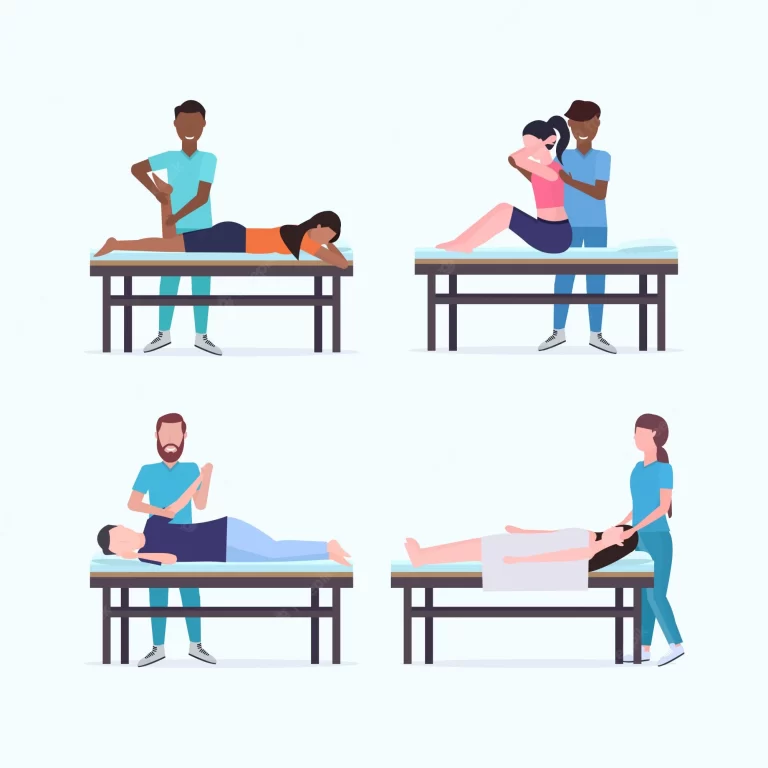


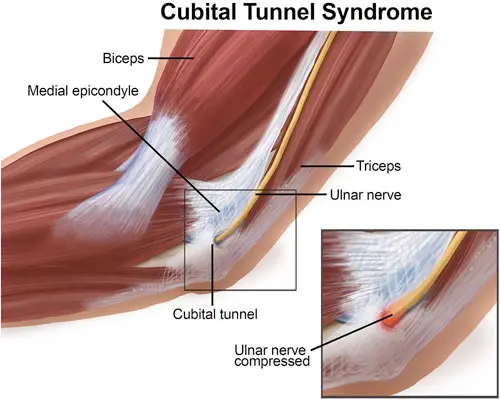
2 Comments